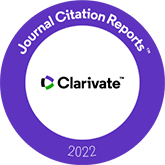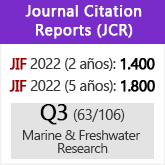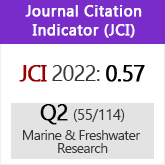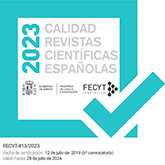Comparación de técnicas para contar procariotas en muestras de biofilm y plancton marino
DOI:
https://doi.org/10.3989/scimar.05117.019Palabras clave:
ecología, enumeración de bacteria, citometría de flujo, métodos microbianos, microscopíaResumen
A pesar de la gran cantidad de técnicas disponibles para el estudio de bacterias acuáticas, el objetivo de este estudio fue aplicar y proponer una técnica para el análisis de células procariotas de vida libre y asociado a biofilms en ensayos de laboratorio. En particular, deseamos analizar la eficiencia de de la aplicación de ultrasonidos para separar y romper el biofilm, obtener un tratamiento de tinción eficiente para cuantificar procariotas de vida libre y de biofilm por citometría de flujo (CF), y comparar microscopía de epifluorescencia (MEP), microscopía electrónica de barrido (MEB) y CF para cuantificar los procariotas de vida libre y de biofilm. Los sustratos de madera contrachapada de grado marino se sumergieron en agua marina natural que se acondicionó durante 12 días. A los 6 y 12 días, se retiraron alícuotas de agua y sustratos para estimar la densidad de procariotas de vida libre y asociados a los biofilms. Los ultrasonidos eliminaron de manera eficiente el biofilm marino de los sustratos (hasta 94%) sin dañar las células. El análisis por CF (sin marcador) cuantificó de manera fiable las células del plancton marino y los procariotas de biofilms jóvenes o maduros en comparación con otras técnicas de marcación (naranja de acridina, 4’, 6-diamidino-2-fenilindol, yoduro de propidio, ácido nucleico fluorescente verde), MEP o MEB. CF y MEB lograron resultados similares, mientras que se observó una alta variabilidad en la técnica EFM. Cuando se compara, CF es más rápido y más preciso que MED, ya que el recuento no depende del observador.
Descargas
Citas
Agostini V.O., Macedo A.J., Muxagata E.M. 2016. Evaluation of antibiotics as a methodological procedure to inhibit free-living and biofilm bacteria in marine zooplankton culture. An. Acad. Bras. Cienc. 88: 733-746. https://doi.org/10.1590/0001-3765201620150454 PMid:27168369
Agostini V.O., Ritter M.N., Macedo A.J., et al. 2017. What determines sclerobiont colonization on marine mollusk shells? PLoS ONE 12: e0184745. https://doi.org/10.1371/journal.pone.0184745 PMid:28902894 PMCid:PMC5597280
Agostini V.O., Macedo A.J., Muxagata E.M. 2018a. Inhibition of biofilm bacteria and adherent fungi from marine plankton cultures using an antimicrobial combination. Inter. Aquatic. Res. 10: 165-177. https://doi.org/10.1007/s40071-018-0198-1
Agostini V.O., Macedo A.J., Muxagata E.M. 2018b. Effect of antimicrobials, salinity, and contamination by air on bacterial and fungal growth in cyprid cultures of Amphibalanus improvisus. Mar. Ecol. 39: e12523. https://doi.org/10.1111/maec.12523
Alsharif R., Godfrey W. 2002. Bacterial Detection and Live/Dead Discrimination by Flow Cytometry. BD Biosciences, San Jose, CA, 6 pp.
Amalfitano S., Fazi S. 2008. Recovery and quantification of bacterial cells associated with streambed sediments. J. Microbiol. Meth. 75: 237-243. https://doi.org/10.1016/j.mimet.2008.06.004 PMid:18602952
Ambriz-Aviña V., Contreras-Garduño J.A., Pedraza-Reyes M. 2014. Applications of flow cytometry to characterize bacterial physiological responses. BioMed Res. Int. 14: 461941. https://doi.org/10.1155/2014/461941 PMid:25276788 PMCid:PMC4174974
Beniac D.R., Hiebert S.L., Siemens C.G., et al. 2015. A mobile biosafety microanalysis system for infectious agents. Sci. Rep. 5: 9505. https://doi.org/10.1038/srep09505 PMid:25820944 PMCid:PMC4377622
Berney M., Hammes F., Bosshard F., et al. 2007. Assessment and interpretation of bacterial viability by using the LIVE/DEAD BacLight kit in combination with flow cytometry. Appl Environ Microbiol 73: 3283-3290. https://doi.org/10.1128/AEM.02750-06 PMid:17384309 PMCid:PMC1907116
Boulos L., Prévost M., Barbeau B., et al. 1999. LIVE/DEAD BacLightE: application of a new rapid staining method for direct enumeration of viable and total bacteria in drinking water. J. Microbiol. Methods 37: 77-86. https://doi.org/10.1016/S0167-7012(99)00048-2
Bouvier T., Troussellier M., Anzil A., et al. 2011. Using light scatter signal to estimate bacterial Bbiovolume by flow cytometry. Cytometry 44: 188-194. https://doi.org/10.1002/1097-0320(20010701)44:3<188::AID-CYTO1111>3.0.CO;2-C
Bunse C., Pinhassi J. 2017. Marine bacterioplankton seasonal succession dynamics. Trends Microbiol 25: 494-505. https://doi.org/10.1016/j.tim.2016.12.013 PMid:28108182
Combs C.A. 2010. Fluorescence microscopy: a concise guide to current imaging methods. Curr. Protoc. Neurosci. 2: Unit2.1. https://doi.org/10.1002/0471142301.ns0201s50 PMid:20066655 PMCid:PMC3805368
Cos P., Tote K., Horemans T., et al. 2010. Biofilms: an extra hurdle for effective antimicrobial therapy. Curr Pharm Des 16: 2279-2295. https://doi.org/10.2174/138161210791792868 PMid:20433417
Crawford G.N.C, Barer R. 1951. The Action of Formaldehyde on Living Cells as Studied by Phase-contrast Microscopy. Q. J. Microsc. Sci., 92(part 4): 403-52. https://doi.org/10.1242/jcs.s3-92.20.403
Dang H., Lovell C.R. 2002. Numerical dominance and phylotype diversity of marine Rhodobacter species during early colonization of submerged surfaces in coastal marine waters as determined by 16S ribosomal DNA sequence analysis and fluorescence in situ hybridization. Appl. Environ. Microbiol. 68: 496-504. https://doi.org/10.1128/AEM.68.2.496-504.2002 PMid:11823183 PMCid:PMC126732
Davey H.M., Kell D.B. 1996. Flow cytometry and cell sorting of heterogeneous microbial populations: the importance of single cell analyses. Microbiol. Rev. 60: 641-696. https://doi.org/10.1128/mr.60.4.641-696.1996 PMid:8987359 PMCid:PMC239459
Davey H.M., Kell D.B. 1997. Fluorescent brighteners: novel stains for the flow cytometric analysis of microorganisms. Cytometry 28: 311-315. https://doi.org/10.1002/(SICI)1097-0320(19970801)28:4<311::AID-CYTO6>3.0.CO;2-E
Falcioni T., Papa S., Gasol J.M. 2008. Evaluating the flow-cytometric nucleic acid double-staining protocol in realistic situations of planktonic bacterial death. Appl. Environ. Microbiol. 74: 1767-1779. https://doi.org/10.1128/AEM.01668-07 PMid:18223113 PMCid:PMC2268295
Felip M., Andreatta S., Sommaruga R., et al. 2007. Suitability of flow cytometry for estimating bacterial biovolume in natural plankton samples: comparison with microscopy data. Eng. Fail. Anal. 73: 4508-4514. https://doi.org/10.1128/AEM.00733-07 PMid:17513595 PMCid:PMC1932810
Fischer E.R., Hansen B.T., Nair V., et al. 2012. Scanning electron microscopy. Curr. Protoc. Microbiol. 2B: 2. https://doi.org/10.1002/9780471729259.mc02b02s25 PMid:22549162 PMCid:PMC3352184
Flemming H-C., Wingender J. 2010. The biofilm matrix. Nat. Rev. 8: 623-633. https://doi.org/10.1038/nrmicro2415 PMid:20676145
Franklin R.B., Campbell A.H., Higgins C.B., et al. 2011. Enumerating bacterial cells on bioadhesive coated slides. J. Microbiol. Methods 87: 154-160. https://doi.org/10.1016/j.mimet.2011.08.013 PMid:21893107
Freitas V. da R., Sand S.T., Simonetti A.B. 2010. Formação in vitro de biofilme por Pseudomonas aeruginosa e Staphylococcus aureus na superfície de canetas odontológicas de alta rotação. Revista de Odontologia da UNESP 39: 193-200.
Gant V.A., Warnes G., Phillips I., et al. 1993. The application of flow cytometry to the study of bacterial responses to antibiotics. J. Med. Microbiol. 39: 147-154. https://doi.org/10.1099/00222615-39-2-147 PMid:8345510
Garren M., Azam F. 2010. New method for counting bacteria associated with coral mucus. Appl. Environ. Microbiol. 76: 6128-6133. https://doi.org/10.1128/AEM.01100-10 PMid:20656857 PMCid:PMC2937480
Gasol J.M., Giorgio P.A. del. 2000. Using flow cytometry for counting natural planktonic bacteria and understanding the structure of planktonic bacterial communities. Sci. Mar. 64: 197-224. https://doi.org/10.3989/scimar.2000.64n2197
Golladay S.W., Sinsabaugh R.L. 1991. Biofilm development on leaf and wood surfaces in a boreal river. Freshwater Biol. 25: 437-450. https://doi.org/10.1111/j.1365-2427.1991.tb01387.x
Harrison J.J., Ceri H., Yerly J., et al. 2006. The use of microscopy and three-dimensional visualization to evaluate the structure of microbial biofilms cultivated in the Calgary Biofilm Device. Biol. Proced. 8: 194-215. https://doi.org/10.1251/bpo127 PMid:17242736 PMCid:PMC1779619
Hobbie J.E., Daley R., Jasper S. 1977. Use of Nuclepore filters for counting bacteria by fluorescence microscopy. Appl. Environ. Microbiol. 33: 1225-1228. https://doi.org/10.1128/aem.33.5.1225-1228.1977 PMid:327932 PMCid:PMC170856
Jin Y., Zhang T., Samaranayake Y.H., et al. 2005. The use of new probes and stains for improved assessment of cell viability and extracellular polymeric substances in Candida albicans biofilms. Mycopathologia 159: 353-360. https://doi.org/10.1007/s11046-004-6987-7 PMid:15883718
Jochem F.J. 2001. Morphology and DNA content of bacterioplankton in the western Gulf of Mexico: Analysis by epifluorescence microscopy and flow cytometry. Aquat. Microb. Ecol. 25: 179-194. https://doi.org/10.3354/ame025179
Kepner R.L.Jr., Pratt J.R. 1994. Use of fluorochromes for direct enumeration of total bacteria in environmental samples: past and present. Microbiol. Mol. Biol. Rev. 58: 603-615. https://doi.org/10.1128/mr.58.4.603-615.1994 PMid:7854248 PMCid:PMC372983
Kerstens M., Boulet G., Van Kerckhoven M., et al. 2015. A flow cytometric approach to quantify biofilms. Folia Microbiol. 60: 335-342. https://doi.org/10.1007/s12223-015-0400-4 PMid:25948317
Kim S.K., Lee J.H. 2016. Biofilm dispersion in Pseudomonas aeruginosa. J. Microbiol. 54: 71-85. https://doi.org/10.1007/s12275-016-5528-7 PMid:26832663
Lopes L.F.P., Agostini V.O., Guimarães S.S, et al. 2018. Evaluation of the effect of antimicrobials in marine cultures, using the copepod Acartia tonsa as a bioindicator. Chem. Ecol. 34: 747-761. https://doi.org/10.1080/02757540.2018.1482886
McKenzie A.T. 2019. Glutaraldehyde: A review of its fixative effects on nucleic acids, proteins, lipids, and carbohydrates. https://doi.org/10.31219/osf.io/8zd4e
Mohammed M.M.A., Nerland A.H., Al-Haroni M., et al. 2013. Characterization of extracellular polymeric matrix, and treatment of Fusobacterium nucleatum and Porphyromonas gingivalis biofilms with DNase I and proteinase K. J. Oral Microbiol. 5: 20015. https://doi.org/10.3402/jom.v5i0.20015 PMid:23372876 PMCid:PMC3559756
Monfort P., Baleux B. 1992. Comparison of flow cytometry and epifluorescence microscopy for counting bacteria in aquatic ecosystems. Cytometry 13: 188-192. https://doi.org/10.1002/cyto.990130213 PMid:1547667
Muthukrishnan T., Govender A., Dobretsov S., et al. 2017. Evaluating the reliability of counting bacteria using epifluorescence microscopy. J. Mar. Sci. Eng. 5: 4. https://doi.org/10.3390/jmse5010004
Nebe-von-Caron G., Stephens P.J., Badley R.A. 1999. Bacterial detection ad differentiation by cytometry and fluorescent probes. Proc. Royal Soc. Lond. 34: 321-327.
Nebe-von-Caron G., Stephens P.J., Hewitt C.J., et al. 2000. Analysis of bacterial function by multi-colour fluorescence flow cytometry and single cell sorting. J. Microbiol. Methods 42: 97-114. https://doi.org/10.1016/S0167-7012(00)00181-0
Oliveira S.S., Wasielesky Jr W.F.B., Ballester E.L.C., et al. 2006. Caracterização da assembléia de bactérias nitrificantes pelo método "Fluorescent in situ Hybridization" (FISH) no biofilme e água de larvicultura do Camarão-rosa Farfantepenaeus paulensis. Atlântica 28(1): 33-45.
Ophus M. 2014. Bacterial community dynamics in a biofilter exposed to a micropollutant. Norwegian University of Science and Technology. 123 pp.
Oulahal N., Martial-Gros A., Bonneau M., et al. 2004. Combined effect of chelating agents and ultrasound on biofilm removal from stainless steel surfaces. Application to "Escherichia coli milk" and "Staphylococcus aureus milk" biofilms. Biofilms 1: 65-73. https://doi.org/10.1017/S1479050504001140
Parthasarathy R. 2018. Monitoring microbial communities using light sheet fluorescence microscopy. Curr. Opin. Microbiol. 43: 31-37. https://doi.org/10.1016/j.mib.2017.11.008 PMid:29175679 PMCid:PMC5963963
Porter K.G., Feig Y.S. 1980. The use of DAPI for identifying and counting aquatic microflora. Limnol. Oceanogr. 25: 943-948. https://doi.org/10.4319/lo.1980.25.5.0943
Posch T., Loferer-Krößbacher M., Gao G., et al. 2001. Precision of bacterioplankton biomass determination: a comparison of two fluorescent dyes, and of allometric and linear volume-to-carbon conversion factors. Aquat. Microb. Ecol. 25: 55-63. https://doi.org/10.3354/ame025055
R Core Team. R. 2017. A language and environment for statistical computing. R Foundation for Statistical Computing, Vienna, Austria. URL https://www.R-project.org/ . 2017.
Sailer M.F., van Nieuwenhuijzen E.J., Knol W. 2010. Forming of a functional biofilm on wood surfaces. Ecol Eng 36: 163-167. https://doi.org/10.1016/j.ecoleng.2009.02.004
Sgier L., Freimann R., Zupanic A., et al. 2016. Flow cytometry combined with viSNE for the analysis of microbial biofilms and detection of microplastics. Nat. Commun. 7: 11587. https://doi.org/10.1038/ncomms11587 PMid:27188265 PMCid:PMC4873979
Shapiro H.M., Nebe-Von-Caron G. 2004. Multiparameter flow cytometry of bacteria. Methods Mol. Biol. 263: 33-44.
Shi L., Günther S., Hübschmann T., et al. 2007. Limits of propidium iodide as a cell viability indicator for environmental bacteria. Cytometry Part A 71A: 592-598. https://doi.org/10.1002/cyto.a.20402 PMid:17421025
Suzuki M.T. 1993. DAPI direct counting underestimates bacterial abundances and average cell size compared to AO direct counting. Limnol. Oceanogr. 38: 1566-1570. https://doi.org/10.4319/lo.1993.38.7.1566
Troussellier M., Courties C., Lebaron P., et al. 1999. Flow cytometric discrimination of bacterial populations in seawater based on SYTO 13 staining of nucleic acids. FEMS Microbiol. Ecol. 29: 319-330. https://doi.org/10.1111/j.1574-6941.1999.tb00623.x
Walberg M., Gaustad P., Steen H.B. 1996. Rapid flow cytometric assessment of mecillinam and ampicillin bacterial susceptibility. J. Antimicrob. Chemother 37: 1063-1075. https://doi.org/10.1093/jac/37.6.1063 PMid:8836810
Xu J., Bigelow T.A., Halverson L.J., et al. 2012. Mechanical destruction of Pseudomonas aeruginosa biofilms by ultrasound exposure. AIP Conf. Proc. 1481: 463-468. https://doi.org/10.1063/1.4757378
Yu M., Wu L., Huang T., et al. 2015. Rapid detection and enumeration of total bacteria in drinking water and tea beverages using a laboratory-built high-sensitivity flow cytometer. Anal Methods 7: 3072-3079. https://doi.org/10.1039/C4AY02919D
Zhang R., Neu T.R., Zhang Y., et al. 2015. Visualization and analysis of EPS glycoconjugates of the thermoacidophilic archaeon Sulfolobus metallicus. Appl. Microbiol. Biotechnol. 99: 7343-7356. https://doi.org/10.1007/s00253-015-6775-y PMid:26169631
Zimmerman R., Meyer-Reil L-A. 1974. A new method for fluorescence staining of bacterial populations on membrane filters. Kiel Meeresforsch. 30: 24-27.
Publicado
Cómo citar
Número
Sección
Licencia
Derechos de autor 2021 Consejo Superior de Investigaciones Científicas (CSIC)

Esta obra está bajo una licencia internacional Creative Commons Atribución 4.0.
© CSIC. Los originales publicados en las ediciones impresa y electrónica de esta Revista son propiedad del Consejo Superior de Investigaciones Científicas, siendo necesario citar la procedencia en cualquier reproducción parcial o total.Salvo indicación contraria, todos los contenidos de la edición electrónica se distribuyen bajo una licencia de uso y distribución “Creative Commons Reconocimiento 4.0 Internacional ” (CC BY 4.0). Puede consultar desde aquí la versión informativa y el texto legal de la licencia. Esta circunstancia ha de hacerse constar expresamente de esta forma cuando sea necesario.
No se autoriza el depósito en repositorios, páginas web personales o similares de cualquier otra versión distinta a la publicada por el editor.
Datos de los fondos
Conselho Nacional de Desenvolvimento Científico e Tecnológico
Números de la subvención 11/2014 (6/2551-000244-4)
















